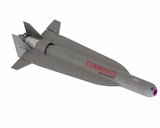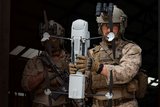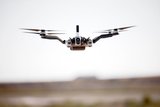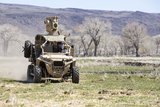Northrop Grumman delivers critical Global Hawk sensor to the US Air Force
Northrop Grumman Corporation delivered the first production Multi-Platform Radar Technology Insertion Program (MP-RTIP) sensor to Edwards Air Force Base for integration on the first US Air Force Block 40 Global Hawk. The first MP-RTIP Global Hawk flight is scheduled to occur by early 2011.
The MP-RTIP technology is unprecedented and unique in its ability to provide critical coverage for the warfighter. MP-RTIP's unique application of advanced technologies can detect multiple stopped, slow and fast-moving objects on the ground in any weather, day or night. This capability combined with the endurance of the Block 40 Global Hawk provides the warfighter with more than 30 hours of greatly improved situational awareness and combat identification per mission.
"The MP-RTIP equipped Global Hawk is an unprecedented combination because it provides greater situational awareness for the warfighter," said George Guerra, vice president High Altitude Long Endurance (HALE) programs. "We are currently on track leading up to first flight and look forward to meeting all upcoming milestones to ensure we provide this critical resource to the warfighter as quickly as possible."
Global Hawk's range, endurance and large payload capabilities are well suited to provide persistent surveillance with MP-RTIP. Flying at altitudes up to 60,000 feet for more than 30 hours per sortie at speeds approaching 340 knots, the MP-RTIP-equipped Block 40 Global Hawk can persistently see through most types of weather, day or night. As the world's first fully autonomous HALE UAS, Global Hawk is the platform of choice for a wide variety of sensors, foreign and domestic, meeting the global need for persistent ISR.
Northrop Grumman Aerospace Systems is the prime contractor for the Global Hawk and MP-RTIP programs and continues to move these technologies forward under the stewardship of the Air Force's Aeronautical Systems Center at Wright-Patterson Air Force Base, Ohio, and Electronic Systems Command at Hanscom AFB. Northrop Grumman Electronic Systems' Norwalk, Conn., facility is teamed with Raytheon Space and Airborne Systems, El Segundo, Calif. to develop, produce and deliver the radar.
Northrop Grumman Aerospace Systems is also prime contractor for the NATO Alliance Ground Surveillance (NATO AGS) system, in which the RQ-4 Block 40 is a key component and managed at the company's Melbourne, Fla. facility.
Northrop Grumman's Global Hawk program is managed at its Aerospace Systems' Unmanned Systems Development Center in San Diego. The company performs Global Hawk sub-assembly work at its Unmanned Systems Center in Moss Point, Miss., and final assembly at its Antelope Valley Manufacturing Center in Palmdale, Calif.
Source: Northrop Grumman
More from Uncrewed Vehicles
-
![Cummings Aerospace showcases Hellhound loitering munition designed for US Army’s LASSO programme (video)]()
Cummings Aerospace showcases Hellhound loitering munition designed for US Army’s LASSO programme (video)
Cummings Aerospace presented its turbojet-powered Hellhound loitering munition at SOF Week 2025, offering a man-portable solution aligned with the US Army’s LASSO requirements.
-
![SOF Week 2025: PDW unveils attritable FPV drone for SOF operations at scale]()
SOF Week 2025: PDW unveils attritable FPV drone for SOF operations at scale
PDW has revealed its Attritable Multirotor First Person View drone at SOF Week 2025, offering special operations forces a low-cost, rapidly deployable platform for strike and ISR missions, inspired by battlefield lessons from Ukraine.
-
![SOF Week 2025: Teledyne FLIR white paper provides guidance on reusable loitering munitions]()
SOF Week 2025: Teledyne FLIR white paper provides guidance on reusable loitering munitions
Teledyne FLIR is highlighting the emerging requirements for 'recoverable and re-usable' loitering munitions across the contemporary operating environment during this week’s SOF Week conference in Tampa, Florida.
-
![SOF Week 2025: Kraken Technology group debuts K3 Scout USV in North America]()
SOF Week 2025: Kraken Technology group debuts K3 Scout USV in North America
High-performance maritime industry player Kraken Technology Group, based in the UK, has used the SOF Week conference in Tampa, Florida this week to debut its K3 Scout uncrewed surface vessel (USV) to the North American market.
-
![Palladyne AI and Red Cat to demonstrate capabilities for autonomous drone swarms to the US military]()
Palladyne AI and Red Cat to demonstrate capabilities for autonomous drone swarms to the US military
Red Cat and Palladyne AI recently conducted a cross-platform collaborative flight involving three diverse heterogeneous drones.
-
Jammer resistant drone designs spark search for countermeasures
The Russia-Ukraine conflict has driven another stage of evolution for drones and the counter measures to defend against them.

























